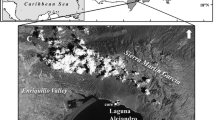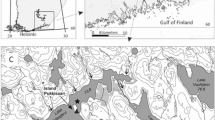Abstract
Recent studies of bloomery sites in Sweden indicate the amount of iron produced with this early low-technology smelter was greater than previously thought, which implies greater economic importance. Little is known about the history of bloomery technology, not least the timeframe over which individual bloomeries were operated, as well as their impact on the landscape because of resource consumption and pollution. In this study we performed pollen and geochemical analyses of the lake-sediment record from Rörtjärnen, which is 120 m from the remains of a documented bloomery [one radiocarbon date: ad 1300–1435 (1 σ)], in Ängersjö, Hälsingland. A surface-soil transect shows a limited geochemical signal only within 20 m of the bloomery, and the sediment pollen record provides little direct evidence of an active bloomery and is consistent with other studied sites in the area linked to forest grazing or cultivation. Instead, we find major changes in sediment geochemistry during ad 800–1200, centered on a unique peak in Pb at ad 1030–1060. These changes include, e.g., Si (biogenic) and P, together with changes in pollen (e.g., Betula, Picea, Cyperaceae), which together indicate disturbance in the forest and especially the adjoining fen. We attribute these changes to a period of bloomery-related activities predating the radiocarbon date of the charcoal from the bloomery, and suggest that date represents a late phase for the site.







Similar content being viewed by others
References
Baron S, Lavoie M, Ploquin A, Carignan J, Pulido M, De Beaulieu JL (2005) Record of metal workshops in peat deposits: history and environmental impact on the Mont Lozère Massif, France. Environ Sci Technol 39:5,131–5,140. doi:10.1021/es048165l
Bentell L (2015) Vad slaggvarpen berättar: om tillverkning av koppar och järn innan och under medeltiden i Europa. In: Berglund B (ed) Järnet och Sveriges medeltida modernisering. Jernkontoret, Stockholm, pp 259–298
Berglund B (2015) Järnet och Sveriges medeltida modernisering. Jernkontoret, Stockholm
Beug HJ (1961) Leitfaden der Pollenbestimmung für Mitteleuropa und angrenzende Gebiete. Fischer, Stuttgart
Bindler R (2011) Contaminated lead environments of man: reviewing the lead isotopic evidence in sediments, peat, and soils for the temporal and spatial patterns of atmospheric lead pollution in Sweden. Environ Geochem Health 33:311–329. doi:10.1007/s10653-011-9381-7
Bindler R, Rydberg J (2015) Revisiting key sedimentary archives yields evidence of a rapid onset of mining in the mid-13th century at the Great Copper Mountain, Falun, Sweden. Archaeometry. doi:10.1111/arcm.12192
Bindler R, Brännvall M-L, Renberg I, Emteryd O, Grip H (1999) Natural lead concentrations in pristine boreal forest soils and past pollution trends: a reference for critical load models. Environ Sci Technol 33:3,362–3,367
Bindler R, Segerström U, Pettersson Jensen I-M et al (2011) Early medieval origins of iron mining and settlement in central Sweden: multiproxy analysis of sediment and peat records from the Norberg mining district. J Archaeol Sci 38:291–300. doi:10.1016/j.jas.2010.09.004
Bindler R, Yu RL, Hansson S, Classen N, Karlsson J (2012) Mining, metallurgy and the historical origin of mercury pollution in lakes and watercourses in Central Sweden. Environ Sci Technol 46:7,984–7,991. doi:10.1021/e5300789q
Blaauw M (2010) Methods and code for ‘classical’ age-modelling of radiocarbon sequences. Quat Geochronol 5:512–518. doi:10.1016/j.quageo.2010.01.002
Brännvall M-L, Bindler R, Renberg I, Emteryd O, Bartnicki J, Billström K (1999) The Medieval metal industry was the cradle of modern large-scale atmospheric lead pollution in northern Europe. Environ Sci Technol 33:4,391–4,395
Breitenlechner E, Hilber M, Lutz J, Kathrein Y, Unterkircher A, Oeggl K (2010) The impact of mining activities on the environment reflected by pollen, charcoal and geochemical analyses. J Archaeol Sci 37:1,458–1,467. doi:10.1016/j.jas.2010.01.006
Breitenlechner E, Goldenberg G, Lutz J, Oeggl K (2013) The impact of prehistoric mining activities on the environment: a multidisciplinary study at the fen Schwarzenbergmoos (Brixlegg, Tyrol, Austria). Veget Hist Archaeobot 22:351–366
Bronk Ramsey C (2009) Bayesian analysis of radiocarbon dates. Radiocarbon 51:337–360
Emanuelsson M (2001) Settlement and land-use history in the central Swedish forest region: the use of pollen analysis in interdisciplinary studies. Acta Universitatis Agriculturae Sueciae: Silvestria 223. Swedish University of Agricultural Sciences, Umeå
Espelund A (2006) Pit Metallurgy? Metalurgija 12:155–164
Farmer JG, Eades LJ, Atkins H, Chamberlin DF (2002) Historical trends in the lead isotopic composition of archival Sphagnum mosses from Scotland (1838–2000). Environ Sci Technol 36:152–157
Forenius S, Hjärthner-Holdar E (2013) Berättelser från markerna: en antologi om järn, skog och kulturarv. Bergslagens medeltidsmuseum, Norberg
Gallagher K, Bodin T, Sambridge M, Weiss D, Kylander M, Large D (2011) Inference of abrupt changes in noisy geochemical records using transdimensional changepoint models. Earth Planet Sci Lett 311:182–194. doi:10.1016/j.epsl.2011.09.015
Giesecke T (2005) Holocene dynamics of the southern boreal forest in Sweden. Holocene 15:858–872. doi:10.1191/0959683605hl859ra
Grimm EC (1991) Tilia v. 2.0.b.4. Illinois State Museum, Research and Collections Center, Springfield
Grimm EC (2004) Tilia Graph v. 2.0.2. Illinois State Museum, Research and Collections Center, Springfield
Hjelle KL, Sugita S (2012) Estimating pollen productivity and relevant source area of pollen using lake sediments in Norway: how does lake size variation affect the estimates? Holocene 22:313–324. doi:10.1177/0959683611423690
Hodson ME (2002) Experimental evidence for mobility of Zr and other trace elements in soils. Geochim Cosmochim Acta 66:819–828. doi:10.1016/S0016-7037(01)00803-1
Hörnberg G, Liedgren L (2012) Charcoal dispersal from alpine Stállo hearths in sub-arctic Sweden: patterns observed from soil analysis and experimental burning. Asian Cult Hist 4:29–42
Hyenstrand Å (1972) Järnframställning i randbygd och problemet i järnbärarland: en kartografisk studie. Jernkontorets forskning H 6. Jernkontoret, Stockholm
Johansson Å, Rickard D (1984) Isotopic composition of Phanerozoic ore leads from the Swedish segment of the Fennoscandian shield. Miner Depos 19:249–255
Johansson Å, Rickard D (1985) Some new lead isotope determinations from the Proterozoic sulfide ores of Central Sweden. Miner Depos 20:1–7
Jouffroy-Bapicot I, Pulido M, Baron S et al (2007) Environmental impact of early palaeometallurgy: pollen and geochemical analysis. Veget Hist Archaeobot 16:251–258. doi:10.1007/s00334-006-0039-9
Karlsson H, Emanuelsson M, Segerström U (2010) The history of a farm-shieling system in the central Swedish forest region. Veget Hist Archaeobot 19:103–119. doi:10.1007/s00334-009-0231-9
Karlsson J, Segerström U, Berg A, Mattielli N, Bindler R (2015) Tracing modern environmental conditions to their roots in early mining, metallurgy, and settlement in Gladhammar, southeast Sweden: vegetation and pollution history outside the traditional Bergslagen mining region. Holocene 25:944–955. doi:10.1177/0959683615574586
Klaminder J, Renberg I, Bindler R, Emteryd O (2003) Isotopic trends and background fluxes of atmospheric lead deposition in N Europe: analyses of three ombrotrophic bogs from south Sweden. Glob Biogeochem Cycles 17:1,019–1,028. doi:10.1029/2002GB001921
Lagerås P (2007) The ecology of expansion and abandonment. Medieval and post-medieval land-use and settlement dynamics in a landscape perspective. Riksantikvarieambetet, Stockholm
Magnusson G (1985) Lapphyttan: an example of medieval iron production. In: Medieval iron in society. Papers presented at the symposium in Norberg May 6–10, 1985. Jernkontorets Forskning H 34. Jernkontoret and Riksantikvarieämbetet, Stockholm, pp 21–60
Magnusson G (1986) Lågteknisk järnhantering i Jämtlands län [Bloomery iron production in the county of Jämtland, Sweden]. Jernkontorets bergshistoriska skriftserie 22. Jernkontoret, Stockholm
Magnusson G (2015) Järnet och Sveriges medeltida modernisering. Jernkontoret, Stockholm
Maier DB, Rydberg J, Bigler C, Renberg I (2013) Compaction of recent varved lake sediments. Gff 135:231–236
Meyer-Jacob C, Tolu J, Bigler C, Yang H, Bindler R (2015) Early land use and centennial scale changes in lake-water organic carbon prior to contemporary monitoring. Proc Natl Acad Sci 112:6,579–6,584
Monna F, Petit C, Guillaumet J-P et al (2004) History and environmental impact of mining activity in Celtic Aeduan territory recorded in a peat bog (Morvan, France). Environ Sci Technol 38:665–673. doi:10.1021/es034704v
Moore PD, Webb JA (1978) An illustrated guide to pollen analysis. Wiley, Chichester
Moore PD, Webb JA, Collinson ME (1991) Pollen analysis, 2nd edn. Blackwell Scientific, Oxford
Peinerud EK, Ingri J, Ponter C (2001) Non-detrital Si concentrations as an estimate of diatom concentrations in lake sediments and suspended material. Chem Geol 177:229–239
Pettersson Jensen I-M (2015) Järnet och Sveriges medeltida modernisering. Jernkontoret, Stockholm
Pettersson G, Karlsson S, Risberg J, M\dal-Runebjer E (2004) Soil chemistry, vegetation history and human impact at the Late Holocene iron production site of Åskagsberg, western Sweden. J Nordic Archaeol Sci 14:101–113
Pinder KC, Eimers MC, Watmough SA (2014) Impact of wetland disturbance on phosphorus loadings to lakes. Can J Fish Aquat Sci 71:1,695–1,703. doi:10.1139/cjfas-2014-0143
Renberg I (1981) Improved methods for sampling, photographing and varve-counting of varved lake sediments. Boreas 10:255–258
Rydberg J (2014) Wavelength dispersive X-ray fluorescence spectroscopy as a fast, non-destructive and cost-effective analytical method for determining the geochemical composition of small loose-powder sediment samples. J Paleolimnol 52:265–276. doi:10.1007/s10933-014-9792-4
Rydberg J, Klaminder J, Rosén P, Bindler R (2010) Climate driven release of carbon and mercury from permafrost mires increases mercury loading to sub-arctic lakes. Sci Total Environ 408:4,778–4,783
Segerström U (2013) Skogen runt blästerugnen RAÄ 1, Ängersjö, Hälsingland. Den lågteknologiska järnproduktionens miljöpåverkan. In: Pettersson Jensen I-M, Berg Nilsson L, Karlsson C (eds) Berättelser från markerna. En antologi om järn, skog och kulturarv. Bergslagens medeltidsmuseum, Norberg, pp 203–216
Segerström U (1997) Long-term dynamics of vegetation and disturbance of a southern boreal spruce swamp forest. J Veget Sci 8:295–306. doi:10.2307/3237359
Viehweider B, Lutz J, Oeggl K (2015) Late-Holocene land use changes caused by exploitation in the mining region of Kitzbühel (Tyrol, Austria). Veget Hist Archaeobot 24:711–729
Acknowledgments
We would like to thank Hanna Staland for her contributions to the pollen analysis and Ingemar Renberg for assistance during sediment coring. This research was funded by grants from the Umeå Center for Environmental Research (CMF) and the Swedish Research Council (2011–3638).
Author information
Authors and Affiliations
Corresponding author
Additional information
Communicated by M.-J. Gaillard.
Rights and permissions
About this article
Cite this article
Karlsson, J., Rydberg, J., Segerström, U. et al. Tracing a bog-iron bloomery furnace in an adjacent lake-sediment record in Ängersjö, central Sweden, using pollen and geochemical signals. Veget Hist Archaeobot 25, 569–581 (2016). https://doi.org/10.1007/s00334-016-0567-x
Received:
Accepted:
Published:
Issue Date:
DOI: https://doi.org/10.1007/s00334-016-0567-x




